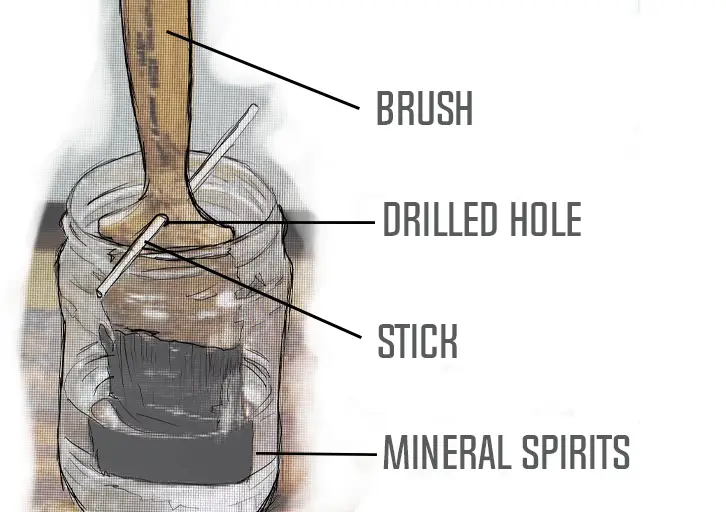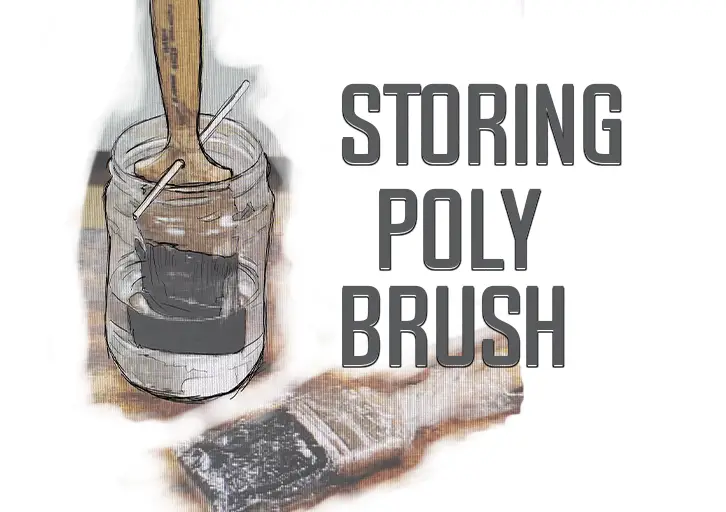Are you tired of constantly having to replace your polyurethane brushes due to neglect and poor maintenance? Proper cleaning and storage of your brushes can not only extend their lifespan, but it can also improve the quality of your finishes. Don’t let a lack of knowledge on how to care for your tools hold you back from achieving professional-grade results. Keep reading to learn the essential techniques for cleaning and storing your polyurethane brushes.
How to clean polyurethane brush
Whether you use water or oil-based polyurethane, the essential part is knowing how to clean your brushes. Let’s look at different ways of removing them.
How to clean oil-based polyurethane off a brush
If you’re a frequent user of oil-based polyurethane, you know that it can be tough to clean off your brushes. Oil’s natural water-resistant properties make it more difficult to remove than other finishes, and the brushes used to apply it tend to be dirtier. But don’t let that deter you from keeping your brushes in top condition. With the right tools and a bit of patience, cleaning your oil-based polyurethane brushes is entirely manageable.
Things you will need.
- A clean piece of cloth
- A well-ventilated workspace
- Plenty of water
- Paint thinner/Mineral spirits
- Face mask
- Dish soap
- A pair of gloves
- Cups
- Nylon scrub brush
Method 1: Cleaning oil-Based Polyurethane Brushes using paint thinners
- The first step is to fill your cup with water but not to the brim
- Add thinner into the water and mix it carefully
- Put your brush into the cup with the solvent
- Bend the brush forth and back to ensure that all the bristles soak your bristles
- Continue bending the brush into the thinner until you see the formation of bubbles and a color change.
- When the thinner is clear, take the brush out of the cup and place it under warm water.
- Add soap to your brush and slowly rub the bristles against your hand
- Repeat the rubbing process until you are completely clear of soap and residue.
- Rinse your brush one last time with warm water before drying it with a microfiber towel
- Make sure you do this every time you use polyurethane.
Method 2: Cleaning oil-Based Polyurethane Brushes Using Mineral Spirits
- Pour mineral spirits into three cups.
- Dip the brush in the first cup and hold it down until all the bristles are covered
- Bend the brush back and forth for the mineral spirits to get in between the bristles
- Once the color in the first cup turns dark brown, move to the next cup and repeat the process.
- Remove the brush from the cups and rinse it under running water
- Apply dish soap to the brush and scrub it thoroughly, running your fingers in between the bristles
- Rinse and repeat the process until you get a clear lather from the brush.
- Hang the brush in your workshop to dry.
Can I put polyurethane over mineral oil?
How to Clean Water-Based Polyurethane Brushes
Things you will need.
- 3Cups
- Dish soap
- A pair of gloves
- Running Water
Step by step on how you clean the brush,
- Fill all the cups with water
- Dip the brush in the first cup and stir it, bending it back and forth until the water gets in between the bristles and changes its color.
- Move the brush onto the next cup and repeat the process until you reach the final cup.
- After that, rinse the brush with running water and add dish soap.
- Scrub the brush with your hands carefully for about three minutes before rinsing it again with running water
- Hang the brush in your workshop to dry.
How to store polyurethane brush between coats
If you need to take a break while using polyurethane, it is important to properly store your brush to ensure it stays in good condition. For water-based polyurethane, storing the brush in the refrigerator can help prevent the bristles from drying out.
For oil-based polyurethane, tightly wrapping the brush in a Ziploc bag and storing it at room temperature will do the trick. When you’re ready to use the brush again, soak it in mineral spirits to soften the bristles and remove excess liquid by wiping it on a rag or paper towel.
Remember to use short strokes when applying the finish to avoid overloading the bristles. Proper storage and handling of your brush will help extend its lifespan and improve the quality of your finishes.
How long should you wait to recoat?
How to store polyurethane brush overnight
If you need to store your polyurethane brush for an extended period of time, there are a few steps you can take to ensure that it stays in good condition. One option is to wrap the brush tightly in plastic wrap, sealing it so that no air can get in. This will prevent the bristles from drying out and becoming stiff or brittle.
Another option is to scrunch the bristles against the bottom of a jar or can filled with mineral spirits, then hang the brush in the container with the mineral spirits covering at least a quarter of the way up the bristles. It’s important to make sure the bristles do not touch the bottom of the jar, as this can cause them to become permanently bent. To prevent this, you can drill an extra hole in the handle of the brush and hang it with the bristles suspended in the mineral spirits.

When you are ready to use the brush again, simply give it a quick shake or rinse to remove any residual solvent before beginning your project. By following these simple steps, you can keep your polyurethane brush in top condition for as long as possible.
What is a polyurethane brush?
A polyurethane brush is a type of paintbrush that is designed for use with polyurethane-based products. These brushes are made with synthetic bristles resistant to wear and tear, making them ideal for heavy-duty projects.
Can we use any brush for poly application? What options do we have?
When applying polyurethane, you have a few different brush options. Natural bristle brushes are the best choice for water-based poly, while synthetic brushes can be used for either water- or oil-based poly. Foam brushes are also an option, but they’re not as durable as the other two types.
Tips To Guide You on How To Clean your Polyurethane Brush
- Type of the Brush
The difficulty in cleaning polyurethane brushes lies in the type of brush you are using. Removing polyurethane from natural bristles is more complex than using a synthetic brush. Since natural hair bristles are longer than synthetic ones, vigorous scrubbing can cause damage to them.
- Be Careful While Working with Solvents
Solvents used in removing polyurethane are made of toxic substances and, therefore, can harm our health. So next time you deal with paint thinner and mineral spirits, ensure you are wearing protective gear and working in a well-ventilated place. It’s also good practice to thoroughly wash your hands after handling solvents and ensure you have a set of nitrile gloves on hand when cleaning brushes with mineral spirit.
Also, check our article on How to Clean Polyurethane the right way | Protect your poly
What type of bristles are used when applying polyurethane?
Depending on the type of polyurethane you are using. Here are different types of brushes you may use.
- Natural bristles
They are used in applying oil-based polyurethane. The brushes are animal hair, making them easy to absorb and spread oil finishes. Natural bristles are quite expensive, so it is important to take good care of them.
- Synthetic Bristles
They are the best for the application of water-based finishes. Synthetic brushes do not pick up a lot of moisture, give a more even coat, and are cheaper than natural brushes.
Bottom Line: Cleaning and Storing Polyurethane Brushes
Cleaning polyurethane brushes save time and money and protect your life and image. Although the cleaning process may seem tedious, the results are admirable. Shown above are different methods of cleaning and storing polyurethane brushes.

